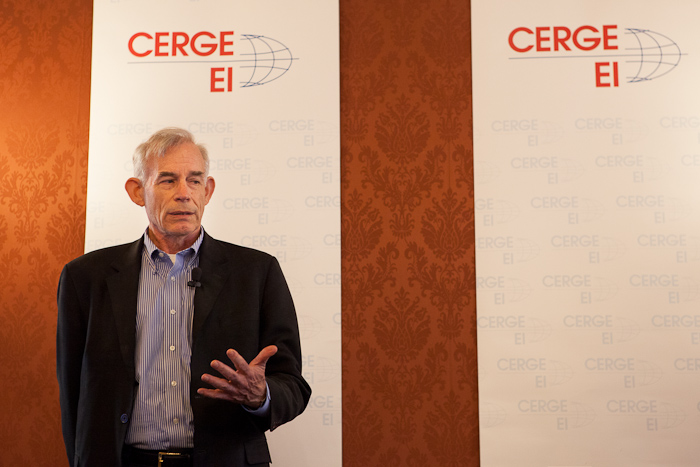Christopher Sims won the Nobel Prize in Economic Sciences in 2011. When he came to CERGE-EI this summer to lecture about his research, we knew we had to sit down with Professor Sims for a more intimate interview. Take a look at the conversation between this brilliant laureate and some of our PhD students at CERGE-EI:
What can you tell us about the journey to winning the Nobel Prize? Where you got your ideas, who influenced you the most, the evolution of the research?
My Nobel Prize is focused on the empirical econometric work I did on monetary policy. My ‘Noble lecture’ kind of goes through that, but I can summarize it: In the 1950s and early 1960s, Keynesian Economics was dominant. And in the 50s, which was very close to the Great Depression, the Keynesian consensus was that monetary policy was not very important and fiscal policy was. And this was a legacy of the period of the Liquidity Trap in the 1930s, when monetary policy indeed was not very effective—a period much like the present, in that respect.
Back then, econometricians developed large statistical models, based on Keysian Theory. They built on the insights of Trygve Haavelmo and Jan Tinbergen, two earlier Nobel Prize winners. And they ended up with very large unwieldy models, for which the statistical methods proposed by Haavelmo didn’t really work very well.
 So into this scene came the monetarists led by Milton Friedman, and they used much simpler statistical models and focused on just a few variables. They argued that the connection between the money stock and income was the central, most important fact in macroeconomics. But this factor didn’t emerge as central and important from the perspective of those big Keynesian models.
So into this scene came the monetarists led by Milton Friedman, and they used much simpler statistical models and focused on just a few variables. They argued that the connection between the money stock and income was the central, most important fact in macroeconomics. But this factor didn’t emerge as central and important from the perspective of those big Keynesian models.
There was really no way for these two schools to resolve their differences with the econometric methods that were available at the time. But in the big Keynesian models, everyone knew they made assumptions that weren’t believable.
So what I did was first I validated the monetarists. They were running regressions of nominal GDP on current and past money stock, and interpreting them as policy-exploitable relationships. They interpreted them as if changing the money stock would change nominal GDP according to the coefficients they estimated in those models. I argued that if that were true, there was a testable implication. This was a causal model. In this logic, future money should not be correlated with income, given past money. So I checked that implication and it turned out that the implication was satisfied by the data.
And so something that both Keynesians and I would have predicted would show that the monetarists were wrong, actually showed they were probably right.
But then a student of mine, Yash Mehra, did a study of so-called ‘Money Demand Equations’. Because at the same time that Friedman was estimating these income-on-money regressions, other people were putting money on the left side and income and interest rates on the right. They were calling this ‘money demand’, and it was another similar equation regression. So I said to Mehra: ‘this looks like a good thing to check, because If money is causing income, than these money demand equations must be nonsense. Money doesn’t belong on the left-hand side.’
But Mahra did the tests and it turned out they passed. He showed that with money on the left and income and interest rates on the right, it looked like everything on the right-hand side satisfied this condition that the future size of the variables shouldn’t matter.
I was puzzled by these results and decided that I wasn’t going to make sense of them unless I put together a model with more than one equation. So I estimated a small, vector regression with several equations, and once I did that I could see that interest rates predict money, and if that’s right, then the usual ‘monetarist’ interpretation of this system didn’t really hold up.
So there is a kind of consensus now on how the economy dynamically responds to monetary expansion or tightening. It’s not really precise, but GDP tends to respond a little quicker than prices, and they both tend to go down when money is tightened. These come right out of quantitative statistical estimates, and there are different ways to do the identification, to separate these two influences. And they give consistent results. That was what the prize was for, that sequence of developments.
What can you tell us in your own opinion about the recent financial crisis in the world economy and where do you see it evolving?
Well there are really two different crises. One is the financial and banking crisis that originated in the US and spread to Europe. And layered on top of that is the EMU (European Monetary Union) crisis which grew out of the problems generated by the US financial crisis.
The US crisis came from growing slack about financial regulation. And that came about in part because of the success in stabilizing the business cycle. There was this period called The Great Moderation from about 1984 through early 2000s, when real variables in the US economy got more and more stable, there was a long period of mostly steady growth, there were some recessions but small ones, and there were financial crises which were successfully resolved with only small and short-run effects on the economy. There was the stock market crash in 1987, the LTCM (long-term capital management) crisis, the dot-com bust. But in each of these cases there was temporary financial distress, rapid reaction by the Fed, and no serious long-term consequences. So people got very confident that the economy was stable.
 And in my view that was the fundamental problem. When it looks like risk is going away, people in financial markets make their money by finding risky investments, which because they’re risky, deliver above average expected return. Well how can you do that if all investments seem to be stable? You have to leverage. So leverage got higher and higher because everything was so stable, and it seemed like to get the level of risk you needed to make above-market returns, you had to get very leveraged. These guys didn’t think they were taking on that big of risk because the economy was so stable. They weren’t thinking about it or weren’t aware of it to some extent, and of course to individual investors it didn’t matter so much that what was happening was a growing risk of a system-wide breakdown.
And in my view that was the fundamental problem. When it looks like risk is going away, people in financial markets make their money by finding risky investments, which because they’re risky, deliver above average expected return. Well how can you do that if all investments seem to be stable? You have to leverage. So leverage got higher and higher because everything was so stable, and it seemed like to get the level of risk you needed to make above-market returns, you had to get very leveraged. These guys didn’t think they were taking on that big of risk because the economy was so stable. They weren’t thinking about it or weren’t aware of it to some extent, and of course to individual investors it didn’t matter so much that what was happening was a growing risk of a system-wide breakdown.
Then on the other side of this were the regulators. Because of ideological considerations, the people who were being appointed to regulatory commissions had the idea that the best thing to do was to get out of the way of the financial markets and allow for financial innovation. Data wasn’t even being collected on these large sectors of non-bank intermediaries who were doing a lot of the dangerous investments.
So the US crisis grew out of both this lack of regulation and out of the dynamic where stability breeds risk-taking and systemic risk. Then we had the crisis and that spread over to the European banking system. In the US, the dire fiscal problems are not as dire. The US government issues nominal debt and that nominal debt promises that when it matures you’ll get a certain amount of dollars, which is paper that the US government prints at very low cost. So there could be inflation but that’s a very different kind of risk than the risk faced by holders of Greek debt today.
The EMU institutions were set up with on the one hand some people saying ‘well markets is going to discipline fiscal authorities, so if they misbehave they will have to pay high interest rates’ and yet on the other hand there was a presumption embodied in ECB policy that because of the Maastricht criteria, no defaults would ever occur in the EU. Well if no defaults can ever occur, there can’t be any risk premium on the debts, so the markets can discipline anything. And still today you see discussion by policy makers as if default is almost unthinkable, even though it’s already happened on Greek debt.
Whereas in the US, there is a risk that we won’t resolve our fiscal problems, and in this case there will be inflation and devaluation and investors in our debt would lose out—but it would be quite uniform and there would be no mystery about which securities would get affected.
In the US we have the institutions, we have congress, we have the Federal Reserve, we have nominal debt, it’s just a matter of deciding if we’re going to raise taxes, cut spending, and if we cut spending whose spending is going to get cut. These are very hard political problems which we are not doing very well at resolving. But we don’t have to create new institutions. In the European Union, they have to create new institutions. They have to admit that default can occur and there ought to be an orderly process for it. And they need to create some kind of European-level security which will have to be backed by some European-level fiscal taxing power that the ECB can use as its policy instrument.
In one of your first interviews, after the award, you said that investment markets are too volatile and you’d like to keep your money in cash for while. Do you still think so?
(Laughs) I don’t think I said they were too volatile. What I said was I would keep it in cash for a while. And in fact it’s still in Sweden right now, earning a little bit of interest there, because I feel I don’t have time to think about what to do with it. But it’s also true that in the current situation, with the volatility in the stock market, it’s not so clear that it’s a bad thing to leave the money ‘idle’ in the bank. Actually that’s the problem in Europe and the US: for most people it seems like not such a bad idea to keep your money in the bank rather than in a productive investment. So I’ve argued that it may be a good thing to have some temporary inflation so that we would be more worried not to have our money invested in something better than a bank account.
You recently published a paper related to Rational Inattention Theory with one of CERGE-EI’s faculty, Filip Matejka. How did you meet Filip Matejka?
Filip was a graduate student in a program in Applied and Computational Mathematics at Princeton. And they encouraged their students to form alliances with faculty outside that department because they are all supposed to be doing work that is applied and not just theoretical. So he came to talk to me. In the end most of his thesis research was using Rational Inattention theory, so I was talking to him more than his own advisor.
Few economic grads had any training in Information Theory, it seems to them hard. Even though a lot of economists are interested in it, it’s an investment to learn enough Information Theory to do anything with it, so there are relatively few people in the field and this gave Filip a chance to make an impact on his own.
You were educated Harvard and Berkeley. CERGE-EI is only here for 20 years. Where do you see advantages and disadvantages for the future of CERGE-EI?

Economics departments in Europe have an opportunity right now. We are witnessing anexpansion in the degree to which people are moving across countries and departments, so quality is going up, and a lot of very good young people are showing up at European universities. And meanwhile American universities, the more prestigious ones, tend to be a bit sluggish in changing their ideas. So I think there is an opportunity for growing younger European departments like CERGE-EI to take the lead in some of the more interesting new areas in economics.
You have published many articles and books. Where do you see the biggest research gap in economics?
I think it’s always too rare that economic theory gets connected to data, in part because people who like to do economic theory tend to be bored by economic data, and the people who like to get their hands on economic data tend to find theory dry and uninteresting. So it requires collaboration— there are few people who do both. But I think it’s an area, a class of areas, not just in economics, where if you can do a good job connecting data and theory, you’ll get attention.
Main Interviewer: Dejan Kovac, 2nd Year PhD Student
5 June 2012

